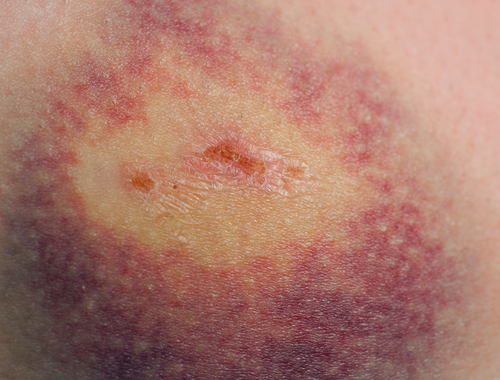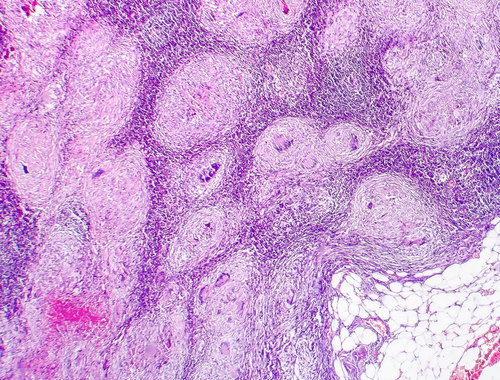Difference Between Bruising and Necrosis
Both bruising and necrosis involve skin discoloration and pain. Specifically, bruises get better after a few days while necrosis has no cure, and the treatment is the removal of the dead tissue. The following further delves into their differences.

What is Bruising?
Bruising is a common skin injury evidenced by skin discoloration. This occurs when damaged blood cells accumulate under the skin which is seen as a black or blue mark (Jaliman, 2021).
The types of bruises based on location are (Weatherspoon, 2018):
- Subcutaneous Bruises
They occur just beneath the skin.
- Intramuscular bruises
They are found in the underlying muscles.
- Periosteal Bruises
They are found on the bones.
Symptoms
A fresh bruise appears reddish and is initially uncomfortable and painful. Within a few hours, it will turn blue or dark purple. After a few days, the pain normally subsides and then when it heals, it will turn yellow or green.
Causes
Bruises are caused by tiny tears in the blood vessels under the skin. We often get bruised when we bump into something. There are some people who easily bruise without apparent reason; this may indicate a bleeding disorder (especially if they often have bleeding gums or nosebleeds). Elderly people may bruise easily since their skin has become thinner the supporting tissues under the blood vessels have become frailer. Moreover, people who take blood thinning medications may be more susceptible to bruising.
Treatment
The usual treatment is cold compress on the affected area for 20 to 30 minutes. This is most effective right after the trauma, while the bruise is still reddish. For large bruises on the foot or leg, the leg should be kept elevated (as much as possible) during the first 24 hours. Pain killers such as acetaminophen may be taken; it should be noted that ibuprofen or aspirin must be avoided as they may slow down blood clotting and prolong bleeding. After around two days, warm compress may be applied for 10 minutes, two to three times a day for the blood flow to increase which allows the skin to reabsorb the blood faster. Vitamin K cream and aloe vera may also be applied to reduce the severity of bruising (Cronkleton, 2017).

What is Necrosis?
Necrosis is the death of body tissues. This occurs when the tissue is not having enough blood. A large area of necrosis is called gangrene. The types of necrosis include the following (Whitlock, 2022):
- Coagulative Necrosis
This is due to the lack of adequate blood flow like when a blood clot blocks an artery. Coagulative necrosis may occur in any organ except the brain.
- Caseous Necrosis
This is normally due to fungal or bacterial infection; the most common cause is tuberculosis.
- Liquefactive Necrosis
This is due to fungal, viral, bacterial, or parasitic infections or ischemic injury. This usually affects the brain, lungs, or tissues surrounding an infection.
- Fibrinoid Necrosis
This occurs within blood vessels and is triggered by immune reactions which damage blood vessels.
- Fat Necrosis
This involves body parts with much fatty tissues such as the breast and pancreas. Fat necrosis is normally caused by injury, surgery, radiation, or other events that cause damage to the tissues.
Symptoms
The general symptoms of necrosis include pain, the affected area feels cool due to lack of blood supply, abnormal sensations such as tingling or burning, numbness, skin discoloration (red, white, dusky, purple, or black), and blisters filled with clear liquid or blood (McBride, 2022).
Causes
The common causes include hypoxia or lack of oxygen (i.e., ischemia or respiratory failure), physical agents (i.e., trauma, frostbite, radiation, or electric shock), chemical agents (i.e., poison, recreational drugs, or occupational exposure), biological agents (i.e., fungi, bacteria, or virus), and immunologic reactions (McBride, 2022).
Treatment
Necrosis has no cure, and the only treatment is the removal of dead tissue (Andigun et al., 2022). Surgery may also be done to remove damaged tissues or restore blood flow. Antibiotics are prescribed to treat or prevent infection.
Difference between Bruising and Necrosis
Definition
Bruising is a common skin injury evidenced by skin discoloration. This occurs when damaged blood cells accumulate under the skin which is seen as a black or blue mark (Jaliman, 2021). Necrosis is the death of body tissues. This occurs when the tissue is not having enough blood. A large area of necrosis is called gangrene (Whitlock, 2022).
Types
The types of bruises based on location are subcutaneous, intramuscular, and periosteal. In comparison, the types of necrosis include coagulative, caseous, liquefactive, fibrinoid, and fat.
Symptoms
A fresh bruise appears reddish and is initially uncomfortable and painful. Within a few hours, it will turn blue or dark purple. After a few days, the pain normally subsides and then when it heals, it will turn yellow or green. As for the general symptoms of necrosis, they include pain, the affected area feels cool due to lack of blood supply, abnormal sensations such as tingling or burning, numbness, skin discoloration (red, white, or black), and blisters filled with clear liquid or blood.
Treatment
The usual treatment for bruises is cold compress on the affected area for 20 to 30 minutes. This is most effective right after the trauma, while the bruise is still reddish. On the contrary, necrosis has no cure, and the only treatment is the removal of dead tissue.
Bruising vs Necrosis

Frequently Asked Questions (FAQs):
Does necrosis look like bruising?
Necrosis may sometimes look like bruising as both involve purple and black skin discoloration. However, skin necrosis is specifically color tan, brown, or black and feels thick, dry, and leathery. The other type of skin necrosis is color yellow, green, or brown, and feels moist and loose.
How can you tell the difference between a bruise and occlusion?
A fresh bruise appears reddish and is initially uncomfortable and painful. Within a few hours, it will turn blue or dark purple. After a few days, the pain normally subsides and then when it heals, it will turn yellow or green. In contrast, a vascular occlusion (VO) happens when a blockage prevents blood from flowing through a blood vessel. This blockage, which may be partial or full, deprives tissue downstream of the blockage of oxygen and other nutrients, eventually leading to skin death or skin necrosis if untreated. The general symptoms of necrosis include pain, the affected area feels cold due to lack of blood supply, abnormal sensations such as tingling or burning, numbness, skin discoloration (red, white, purple, or black), and blisters filled with clear liquid or blood (McBride, 2022).
How do you know when a bruise is serious?
You should see a doctor when the bruise is accompanied by extreme pain; when it does not heal after two weeks; if you are taking blood thinning medications; and if you have them easily without apparent reason.
How do you know if you have necrosis after fillers?
The symptoms include skin discoloration (dusky, blue, or black), pain, and skin breakdown. The affected area may also feel cold and become pale or white.
What does the start of necrosis look like?
The start of skin necrosis may appear reddish and swollen, skin blisters appear, and grayish smelly liquid may drain from the wound.
Summary
- Bruising is a common skin injury evidenced by skin discoloration. This occurs when damaged blood cells accumulate under the skin which is seen as a black or blue mark.
- Necrosis is the death of body tissues. This occurs when the tissue is not having enough blood.
- A fresh bruise appears reddish and is initially uncomfortable and painful. Within a few hours, it will turn blue or dark purple.
- As for the general symptoms of necrosis, they include pain, the affected area feels cool due to lack of blood supply, abnormal sensations such as tingling or burning, numbness, skin discoloration (red, white, or black), and blisters filled with clear liquid or blood.
- The usual treatment for bruises is cold compress while necrosis has no cure, and the only treatment is the removal of dead tissue.
- Difference Between Hematoma and Melanoma - February 9, 2023
- Difference Between Bruising and Necrosis - February 8, 2023
- Difference Between Brain Hematoma and Brain Hemorrhage - February 8, 2023
Search DifferenceBetween.net :
Leave a Response
References :
[0]Andigun, R., Basit, H., & Murray, J. (2022). Cell liquefactive necrosis. National Library of Medicine. https://www.ncbi.nlm.nih.gov/books/NBK430935/
[1]Cronkleton, E. (2017). 10 ways to get rid of bruises. Healthline. https://www.healthline.com/health/how-to-get-rid-of-bruises
[2]Jaliman, D. (2021). Bruises. WebMD. https://www.webmd.com/skin-problems-and-treatments/guide/bruises-article
[3]McBride, M. (2022). What is necrosis? Healthgrades. https://www.healthgrades.com/right-care/injuries-and-wounds/necrosis
[4]Weatherspoon, D. (2018). What’s causing these black and blue marks? Healthline. https://www.healthline.com/health/bruise
[5]Whitlock, J. (2022). Necrosis causes and symptoms in the human body. Verywell Health. https://www.verywellhealth.com/what-is-necrotic-tissue-3157120
